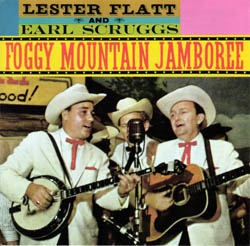
|
Foggy Mountain Jamboree |
|
COME UP THE MIDDLE AND DUCK OUT TO THE SIDE
liner notes by John Hartford
The Foggy Mountain Boys had no idea what effect they were
having on teenaged Doug Dillard and John Hartford in the Missouri of
the late '50s. We played with the banjo strap on the shoulder and the
hat cocked just so, fully believing how important that was to the sound.
Years later, we found out that the strap went that way so Earl Scruggs
wouldn't have to take off his hat and mess up his hair.
"Foggy Mountain Jamboree" was the first album devoted to this
kind of music. We couldn't slow it down much, as we had done with our old
78s, to study the banjo in slow motion, but it included two songs we'd never
heard before. "Blue Ridge Cabin Home" and "Your Love Is Like A Flower;" and
what a beautiful cover. The photo showed Earl's hand position on the banjo
so we could stand in front of the mirror comparing ours to his. The dark
smudges on the banjo were showing us how far from the bridge to pick.
One of the great rewards of being a professional in this business
has been to get to know Earl Scruggs, Lester Flatt, Benny Martin, Uncle Josh,
Curly Seckler, Paul Warren and Jake Tullock well enough to know what the
view had been from their perspective. We feel that, historically, the great
revolutions in music have been in the rhythm sections. Earl was an architect
of this sound which he originally brought to Bill Monroe's Blue Grass Boys
in the middle 1940s. He said Benny Martin and Bill Monroe were like prize
fighters and needed something to punch against, that sense of "doing battle"
gave the band that powerful edge.
Uncle Josh said Earl told him that they should never both be playing
a roll at the same time and that only one should back up at a time and that
was after your solo, and basically to save it until you got on the mike. Also
not to pat your foot - it comes through the mike stand. Earl says that for a
band to be good you should play at least five shows a week. He says most all
the licks he ever played came to him on stage or in a jam session. One time
Sonny Osborne picked up Earl's banjo and remarked on how slick the strings
were. "How'd you get'em that way?" he asked. Earl winked and said "You have
to play on 'em real hard for about two months."
Earl always told the band that the pick-up notes were real important;
so whoever was soloing; be out of the way in time for the next fella to play
his pick-up notes in the mike. Josh said when he first came in to the band, he
didn't get out of the way in time and knocked Earl's bridge down. He knew for sure
that would be a bus ticket back home, but fortunately, he thought fast, and got
back in there and finished the solo.
Flint Hill Special is the best 78rpm record we ever
heard or owned. We had two 78s: the first was worn to almost complete cratch from
so many listenings; a great thing about a 78 record is you can slow it down and
hear all the wonderful complexity of the interior of a banjo style that worked well
at any speed. We would play those rolls in the low register of the piano. Sensitive
to the amount a thumb string has to sound, it can't be too much and it can't be too
little. The way the banjo seconds the fiddle during the second part of the second,
third and fourth fiddle breaks became the pattern for accompanying the fiddlers
we grew up with after we learned three-finger style. The notes of that banjo were
a reddish white orange color that made for a picture of an old car hurling down a
mountain road, at break-neck speed.
In later years, Benny Martin said he really didn't know
the tune very well and they cut it in one take, which would explain why the fiddle
breaks develop the melody rather than repeat it. Benny said the reason they played
so well was they "didn't know where straight up was" and were just playing; not
trying. He heard me on the radio the other night and said that I was "trying too
hard." Back then we called it old-time country music or mountain music. The phrase
bluegrass music hadn't come along.
This was radio music and they mixed themselves. When everyone
was singing the volume came way down and only one instrument backed up. They played
over one mike, and learned to work in and out. One time, on the Grand Ole Opry,
Lightning Chance leaned in to see how they were doing it and Hylo Brown pulled the
bass back quickly and laid his head open. The show was choreographed like a football
play. Come up the middle and duck out to the side.
John Hartford
Click here for the Order Form
Back to the Merchandise Catalog
© 2000 Earl Scruggs